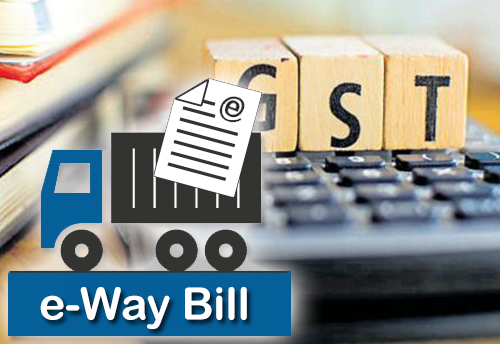E-way bill is a document required to be carried by a person in charge of the conveyance carrying any consignment of goods of value exceeding fifty thousand rupees as mandated by the Government in terms of section 68 of the Goods and Services Tax Act read with rule 138 of the rules framed there under. It is generated from the GST Common Portal by the registered persons or transporters who cause movement of goods of consignment before commencement of such movement.
Why is the e-way bill required?
Section 68 of the Goods and Services Tax Act mandates that the Government may require the person in charge of a conveyance carrying any consignment of goods of value exceeding such amount as may be specified to carry with him such documents and such devices as may be prescribed. Rule 138 of Karnataka Goods and Services Tax Rules, 2017 prescribes e-way bill as the document to be carried for the consignment of goods of value more than rupees fifty thousand. Government has issued a notification under rule 138 of Goods and Services Tax Rules, 2017 mandating to carry e-way bill for transportation of goods of consignment of value more than rupees fifty thousand. Hence e-way bill generated from the common portal is required to be carried.
Who all can generate the e-way bill?
Every registered person who causes movement of goods of consignment value exceeding fifty thousand rupees in relation to supply; or reasons other than supply; or inward supply from unregistered person shall generate e-way bill. It means, the consignor or consignee, as a registered person or a transporter of the goods can generate the e-way bill. The unregistered transporter can enroll on the common portal and generate the e-way bill for movement of goods for his clients. Any person can also enroll and generate the e-way bill for movement of goods for his/her own use.
What are pre-requisites to generate the e-way bill?
To generate the e-way bill, it is essential that the person shall be registered person and if the transporter is not registered person it is mandatory to get enrolled on the common portal of e-waybill (http://ewaybill.nic.in) before generation of the e-way bill. The documents such as tax invoice or bill of sale or delivery challan and Transporter’s Id, who is transporting the goods with transporter document number or the vehicle number in which the goods are transported.
If there is a mistake or wrong entry in the e-way bill, what has to be done?
If there is mistake, incorrect or wrong entry in the e-way bill, then it cannot be edited or corrected.
Whether e-way bill is required for all the goods that are being transported?
The e-way bill is required to transport all the goods with the value exceeding fifty thousand rupees except the goods specified in Annexure to the notification.
Is there any validity period for e-way bill?
Yes. Validity of the e-way bill or consolidated e-way bill depends upon the distance the goods have to be transported. The validity is one day upto 100 km and for every 100 km or part thereafter it is one additional day.
Which types of transactions that need the e-way bill?
For transportation of goods in relation to all types of transactions such as outward supply whether within the State or interstate, inward supply whether from within the State or from interstate including from an unregistered persons or for reasons other than supply also e-way bill is mandatory.
Who is required to generate the e-way bill?
Every registered person, who causes movement of goods, needs to generate the e-way bill. If the registered person is unable to generate the e-way bill, the transporter who transports the goods can generate the e-way bill on behalf of his/her client. If the movement is caused by an unregistered person, he may at his option generate the e-way bill.
What is the Part-A Slip?
Part-A Slip is a temporary number generated after entering all the details in PART-A. This can be shared or used by transporter or yourself later to enter the PART-B and generate the E-way Bill. This will be useful, when you have prepared invoice relating to your business transaction, but don’t have the transportation details. You can enter invoice details and keep it ready for transportation, once the transportation is ready.
When I enter the details in e-way bill form, the system is not generating the e-way bill, but showing the Part-A Slip?
If you don’t enter the vehicle number for transportation by road or transport document number in other cases, the system will show you the PART-A slip. It indicates that still you have not completed the e-way bill generation process. Once you enter the part-B details for this unique number, e-way bill be generated.
How to generate e-way bill from Part-A Slip?
Part-A Slip is entry made by user to temporarily store the document details on the e-way bill system. Once the goods are ready for movement from the business premises, the user can enter the Part-B or vehicle details and generate the e-way bill for movement of goods. Hence, Part-B details convert the Part-A slip into e-way bill.
What are the documents that need to be carried along with the goods being transported?
The person in charge of a conveyance shall carry the tax invoice or bill of supply or delivery challan, bill of entry as the case may be; and a copy of the e-way bill or the e-way bill number generated from the common portal.
How to generate the e-way bill from different registered business places?
The registered person can generate the e-way bill from his account from any registered business place. However, he/she needs to enter the address accordingly in the e-way bill. He/she can also create multiple sub-users and assigned to these places and generate the e-way bills accordingly.
How does the taxpayer enter the Part-A details and generate the e-way bill later by entering Part-B?
The taxpayer can enter Part-A details and generate the Part-A slip. Sometimes, the taxpayer wants to move the goods himself but wants to update the Part-B later as vehicle number is not available at that point of time. E-way bill expects the user to enter transporter ID or vehicle number. So if he wants to move the goods himself, he can enter his GSTIN as transporter Id and generate Part-A Slip. This indicates to the system that he is a transporter and is going to enter Part-B later.
What has to be entered in GSTIN column, if consignor or consignee is not having GSTIN?
If the consigner or consignee is unregistered taxpayer and not having GSTIN, then user has to enter URP’s [Unregistered Person] in corresponding GSTIN column.
When does the validity of the e-way bill start?
The validity of the e-way bill starts when first entry is made in Part-B. That is, vehicle entry is made first time in case of road transportation or first transport document number entry in case of rail/air/ship transportation, whichever is the first entry. It may be noted that validity is not re-calculated for subsequent entries in Part-B.
How is the validity of the e-way bill calculated?
The validity period of the EWB is calculated based on the ‘approx. distance’ entered while generating the EWB. For every 100kms one day is a validity period for EWB as per rule and for part of 100 KM one more day is added. For ex. If approx. distance is 310KMs then validity period is 3+1 days.
Whether e-way bill is required, if the goods are being purchased and moved by the consumer to his destination himself.
Yes. As per the rules, e-way bill is required to be carried along with the goods at the time of transportation, if the value is more than Rs 50,000.00. Under this circumstance, the consumer can get the e-way bill generated from the taxpayer or supplier, based on the bill or invoice issued by him. Or the consumer can enroll and log in as the citizen and generate the e-way bill.
Can the e-way bill be modified or edited?
The e-way bill once generated, cannot be edited or modified. Only Part-B can be updated to it. However, if e-way bill is generated with wrong information, it can be cancelled and generated freshly again. The cancellation is required to be done within twenty four hours from the time of generation.
Before submission, the system is not allowing to edit the details.
The system allows editing the details of e-way bill entries before submission. However, if the products/commodities details are entered, it will not allow editing some fields as the tax rates will change. To enable this, please delete the products and edit the required fields and enter the products again.
The system shows the ‘Invalid Format’ when we are trying to enter the vehicle number
The system expects you to enter the vehicle number details in proper format. Please see the format details in the help with the vehicle entry field.
How can anyone verify the authenticity or the correctness of e-way bill?
Any person can verify the authenticity or the correctness of e-way bill by entering EWB No, EWB Date, Generator ID and Doc No in the search option of EWB Portal (http://ewaybill.nic.in).
How to generate e-way bill for multiple invoices belonging to same consignor and consignee?
If multiple invoices are issued by the supplier to recipient, that is, for movement of goods of more than one invoice of same consignor and consignee, multiple EWBs have to be generated. That is, for each invoice, one EWB has to be generated, irrespective of same or different consignors or consignees are involved. Multiple invoices cannot be clubbed to generate one EWB. However after generating all these EWBs, one Consolidated EWB can be prepared for transportation purpose, if they are going in one vehicle.
What has to be done by the transporter if consignee is refuses to take goods or rejects the goods for quality reason?
There is a chance that consignee or recipient may reject to take the delivery of consignment due to various reasons. Under such circumstance, the transporter can get one more e-way bill generated with the help of supplier or recipient by indicating supply as “˜Sales Return’ and with relevant document details and return the goods to supplier as per his agreement with him.
What has to be done, if the validity of the e-way bill expires?
If validity of the e-way bill expires, the goods are not supposed to be moved. However, under circumstance of “exceptional nature”, the generator of the e-way bill can generate another e-way bill, by entering the e-way bill number and part-B. Now, the system generates the new e-way bill with part-A information of previous e-way bill and new Part-B information.
How to enter invoice having different states for “Bill to” and “Ship to” places and what will be the tax rates?
If the addresses involved in ‘Bill to’ and ‘Ship to’ in an invoice/bill belongs to one legal name/taxpayer as per GSTIN within the state, then one e-way bill has to be generated. That is, if the ‘Bill to’ is principal place of business and ‘Ship to’ is additional place of business of the GSTIN or vice versa in a invoice/bill, then one e-way bill is sufficient for the movement of goods.
If the addresses involved in ‘Bill to’ and ‘Ship to’ in a invoice/bill belongs to different legal names/taxpayers, then two e-way bills have to be generated. One e-way bill for first invoice, second e-way bill is from ‘Bill to’ party to ‘Ship to’ party based on the invoice/bill of the ‘Bill to’ party. This is required to complete the cycle of transactions and taxes will change for inter-state transactions.
For example, A has issued invoice to B as ‘Bill to’ with C as ‘Ship to’. Legally, both B and C are different taxpayers. Now, A will generate one e-way bill and B will issue invoice and generate one more e-way bill. As goods are moving from A to C directly, the transporter will produce both the invoices and e-way bills to show the shortcut movement of goods.
How the transporter is identified or assigned the e-way bill by the taxpayer for transportation?
While generating e-way bill the taxpayer has a provision to enter the transporter id in the transportation details section. If he enters 15 digits transporter id provided by his transporter, the e-way bill will be assigned to that transporter. Subsequently, the transporter can log in and update the further transportation details to it.
How to generate e-way bill, if the goods of one invoice is being moved in multiple vehicles simultaneously?
Where the goods are being transported in a semi knocked down or completely knocked down condition the EWB shall be generated for each of such vehicles based on the delivery challans issued for that portion of the consignment and;
(a) the supplier shall issue the complete invoice before dispatch of the first consignment;
(b) the supplier shall issue a delivery challan for each of the subsequent consignments, giving reference of the invoice;
(c) each consignment shall be accompanied by copies of the corresponding delivery challan along with a duly certified copy of the invoice; and
(d) the original copy of the invoice shall be sent along with the last consignment
Please note that multiple EWBs have to generate under this circumstance. That is, the EWB has to be generated for each consignment based on the delivery challan details along with the corresponding vehicle number.
For GST Certification – https://www.vskills.in/certification/accounting-banking-and-finance/gst-professional
For GST questions and free Test – https://vskills.in/practice/quiz/gst-professional




